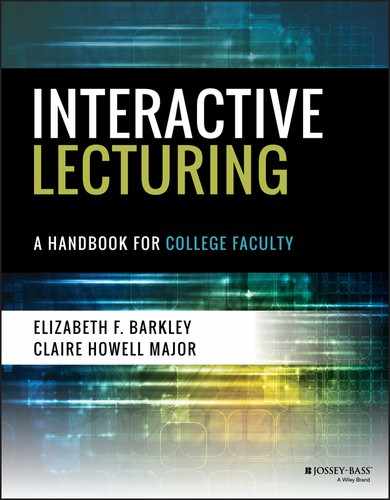ENGAGING LECTURE TIP 1
Big Why, Little Why
Every presentation has a communication purpose. Thinking through the general and the specific purposes of an upcoming talk is a critical step because these purposes can direct the presentation's shape and form, providing guidance during the planning process. Keeping your purposes at the forefront of your mind as you craft and communicate your message helps you identify the most important content and forgo unessential or less essential content. Crafting Big Why, Little Why statements can help you to shape the organization and sequencing of your message and to frame it in a way that aligns with your goals.
Knowing your whys will enable you to craft your message for the particular group of students who will hear it, to find a better match between your goals and the students' goals, and to better manage student expectations as well as better meet students' needs. (Students bring their own whys with them. See Tip 3: Student Characteristics Analysis for how to help identify students’ whys.)
The Big Why involves identifying the main reason for choosing to share information through a lecture instead of another medium. In most college lectures, the Big Why is to provide students with information they do not already have, but you might also want to persuade and even to entertain. Although you may be wary of these secondary purposes, they are playing a greater role in today's higher education classrooms. For example, many college teachers see their roles as advocates of social justice. Also, many instructors are increasingly aware of the importance of being interesting, perhaps even entertaining, to the students who are listening in order to capture their attention and thus facilitate deeper learning. Your Big Why should not only be related to course goals and objectives, but it should also identify the greater purpose of lecturing. A few possible reasons include the following:
- To share your enthusiasm for a topic you care about
- To provide an alternative point of view or different approaches to the subject, concepts, or theories than the one(s) presented in readings
- To help students develop important skills, such as critical listening and effective note-taking
Articulating the Big Why creates the larger framework for the lecture and is an important first step in planning an effective presentation. The Little Why is the reason you have chosen to offer a presentation on a particular subject, at a particular time, to a particular group of students. Consider the following questions: What gets you excited about this topic? Why do you want students to learn about this topic? A few possible reasons include the following:
- To focus on a difficult point, concept, or theory and to provide explanation and details that will benefit students
- To place course material in context
- To interpret the text
- To address or demonstrate problems not presented in the text
- To provide essential information necessary for students to understand information to come
The Little Why provides a more direct lecture purpose.
Your Big Why and Little Why combine to form a statement that can guide the intent, scope, and direction of your talk and present a plan about the development of the argument. It can be useful to explain to students your Big Why so that they understand you are choosing to lecture with intentionality and purpose. It can also be useful to help students understand the purpose of a particular presentation (the Little Why). To craft your statement, write a single declarative sentence that summarizes the specific topic and goals of your lecture for the Big Why and Little Why.
- Big Why. The purpose of lecturing is to . . .
- Little Why. The aim of this particular lecture is to . . .
Big Why, Little Why encourages not only thinking about pedagogy but also articulating your general and specific purposes for offering a presentation. Your Big Why and Little Why should be important and worthy for you to craft the lecture and for students to listen to the lecture.
Example
Key References and Resources
- Ford, N., McCullough, M., & Schutta, N. T. (2012). Presentation patterns: Techniques for crafting better presentations. Boston, MA: Addison Wesley.
- Sproat, E., Driscoll, D. L., & Brizee, A. (2013, March 1). Purposes. Retrieved from https://owl.english.purdue.edu/owl/resource/625/06/
- University of Hawaii. (n.d.a). Specific purpose statements. Retrieved from www.hawaii.edu/mauispeech/html/your_purpose.html
- University of Wisconsin. (2014). Thesis or purpose statements. Writers handbook. Retrieved from http://writing.wisc.edu/Handbook/Thesis_or_Purpose.html
